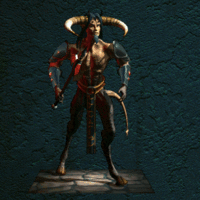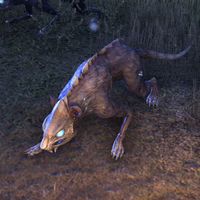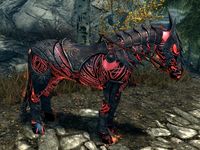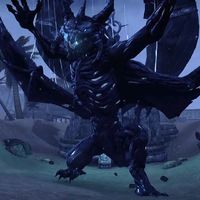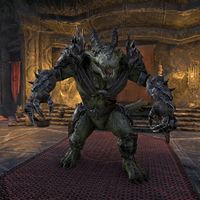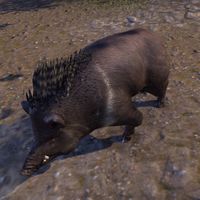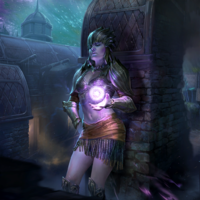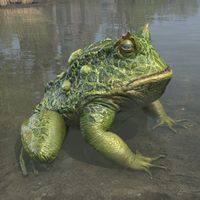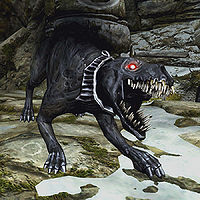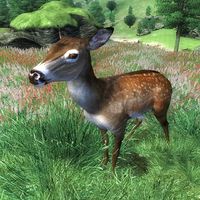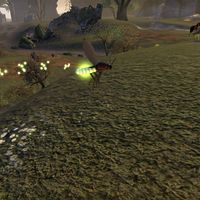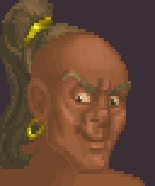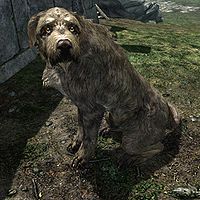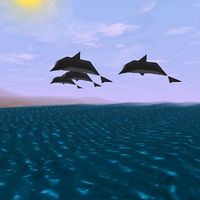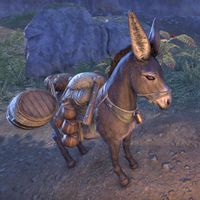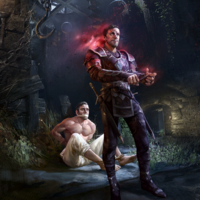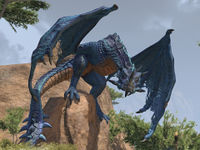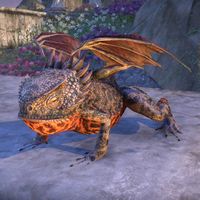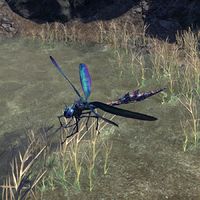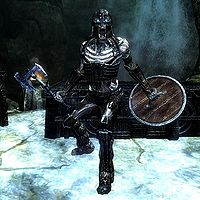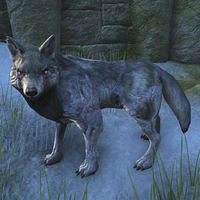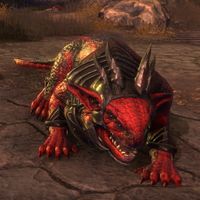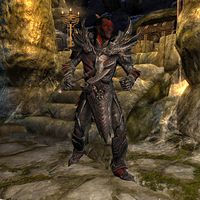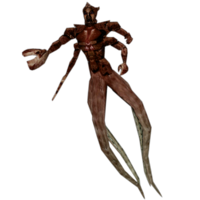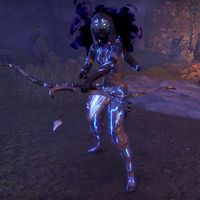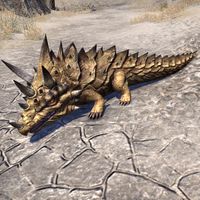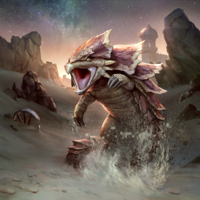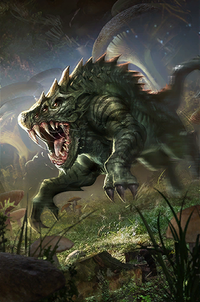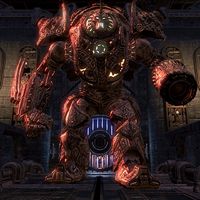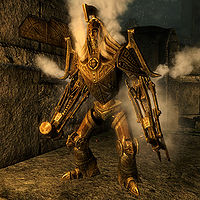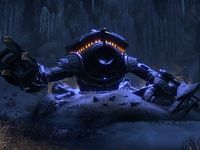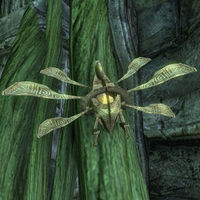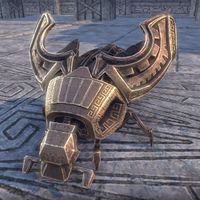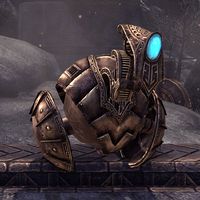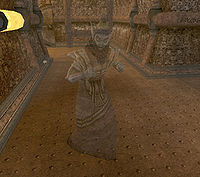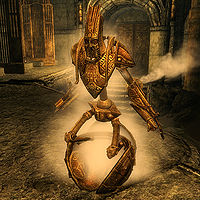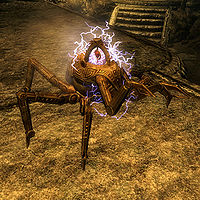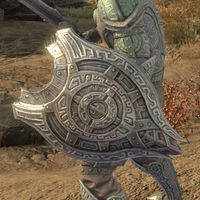Lore:Bestiary D
Daedra Count[edit]
A Daedra Count is a formidable, and highly intelligent greater Daedric being. Described as middle nobility of the Daedra,[1]:63 they have command over many Lesser Daedra. They are known to have a strong sense of honor, and even show respect to mortals. They can cast a variety of spells, but also are proficient in close quarters combat. Many of these high-ranking Daedra are known to serve Mehrunes Dagon.[2]
Daedra Lord[edit]
A Daedra Lord (also spelled Daedric Lord or Daedroth Lord)[nb 1] is a greater Daedric being who occupies a rarefied space near the top of Daedric society, just one rung down from the Daedric Princes themselves, maintaining great power and hierarchy over Oblivion that is matched only by the Demiprinces, and exceeded only by the Daedric Princes. The powers of the Daedra Lords are varied in scope, with some embodying their own individual spheres, and others being servants of the Daedric Princes who help maintain sub-spheres. Many of the more powerful Lords also rule over their own realms and demi-planes within the infinite swirling void of Oblivion.
Daedra Lords are one of the most powerful Daedra to be commonly seen in Tamriel, and are to be feared by all but the most experienced adventurers. They are known to be powerful fighters and spell casters, and can only be harmed by mithril or better weapons. Mehrunes Dagon has many Daedra Lords in his service.
Daedmite[edit]
Daedmites are a type of Daedric vermin, creatures similar to pests of the mortal world. Daedmites are considered particularly unpleasant to speak of. They are known to be found in Apocrypha.[3]
Daedrat[edit]
Daedrats are Daedric vermin resembling large, ragged rats with glowing blue eyes. Some Dremora consider them cute despite the fact that Daedrats are considered vermin.[4][5] Their meat is known to upset dogs' stomachs.[6] Their appearance varies depending on their plane of origin.[5]
Daedric Horse[edit]
Daedric Horses are a type of Daedra resembling fiery glowing red horses covered in black tattoos. Usually hostile, the beasts possess a flaming body and leave behind fire salts when banished. Instead of hair, the creature's tail consists of several spiked flails. Daedric Horses are used as mounts by the Dremora of the Deadlands, and can also be summoned to Tamriel.
- See also: Nightmare Courser
Daedric Titan[edit]
Daedric Titans, commonly referred to simply as Titans, are giant winged Daedra that serve Molag Bal as war-slaves. They were first created in imitation of the Dragons of Nirn when Bal's interrogation of Boziikkodstrun proved fruitless. After modifying Boziikkodstrun's skeleton and substituting his soul for a Daedric vestige, Bal created the first Titan. Daedric Titans are anatomically similar to Dragons, although with dark black skin and prehensile frontal limbs. They have the ability to speak a spell of flaming essence-drain that can debilitate an opponent with a single word, similar to the power of the thu'um. They are notoriously difficult to kill.
They serve Molag Bal as the guardians of souls, and therefore the keepers of black soul gems. However, they are also posted to guard other strategic resources. According to some sources, Titans were released upon Tamriel for the first time[nb 1] during the attempted Planemeld of the Second Era. Specifically, Molag Bal released them into the skies over the Imperial City when a portal to Coldharbour was opened above the White-Gold Tower in 2E 582.
Daedric Titans eventually came to serve other Daedric Princes, such as Boethiah, who had them summoned to fight mortals for her amusement. Mehrunes Dagon has Ash Titans in his army. Unlike their blue cousins, Ash Titans have red skin, and breathe regular flames rather than blue cold-fire.
Daedroth[edit]
Daedroths are crocodile-headed bipedal Daedra, associated with Molag Bal and Mehrunes Dagon. They are a strong, animalistic type of Daedra, but still a dangerous foe with powerful clawed arms and moderate magical ability. Though some have been known to use weapons and wear simple armor, most attack with bare claws. Some are man-sized and spit poison or shock magic, while others tend to be larger and belch firebolts instead. These larger Daedroths initiate battle by shaking themselves, invoking a protective shield.
Linguists will point out that "Daedroth" is also the proper singular form of "Daedra", but for these creatures the common usage is Daedroth (singular) and Daedroths (plural), with Daedra (both singular and plural) being used as the generic term. The more proper, specific name for them is "Daedralings". The term "Lesser Daedra" is sometimes used (again, both singular and plural), though this appellation technically refers to Daedra of all types beneath the Daedric Princes.
Daggerback[edit]
Daggerbacks are a type of boar with quills found along their backs. They can be found in many places throughout Tamriel, including Craglorn, Elsweyr, the Gold Coast and Wrothgar. Their meat is said to have a strong taste, and is said to be the best in stew.[7]
Dark Seducer[edit]
Dark Seducers (or simply Seducers) are a type of Daedra that typically resemble scantily clad women. They are intelligent but many of them normally refuse communication with anyone from Mundus. Dark Seducers are both powerful spell casters and melee fighters. Those in service to Sheogorath call themselves the "Mazken", and are usually friendlier to mortals. Those in service to Mehrunes Dagon typically have wings and are sometimes referred to as Daedra Seducers.
Death Hopper[edit]
Death hoppers are giant, carnivorous frogs that can be found in the swamps of Blackwood and the West Weald. They are typically green, but can also be black. Death hoppers are generally found in packs. They hunt by lurking beneath the surface of water, waiting for their prey to wander above them. They can swallow large prey whole.[8] Death hoppers are extremely poisonous, and can spit globs of toxic matter over great distances.[8] The Sul-Xan tribe is known to use death hopper vocal sacs when making armor.[9] They are known to spawn in the foul waters of the West Weald, their tadpoles are known as Death Hopper Nymphs.[10]
Death Hound[edit]
Death Hounds are monstrous, undead canines who can often be found in the company of vampires. They have a bite as cold as the grave, which freezes its prey's flesh. Their meat is edible, and they often wear valuable collars.
- See also: Bonewolf, Hell Hound, and Skinned Hound
Deer[edit]
Deer are herbivorous mammals seen in the forests of Cyrodiil and Skyrim. They are often hunted for their meat and pelts. They are very skittish and will quickly flee potential danger.[11] A male deer is called a stag, and a female deer is a doe. Stags have antlers, and does lack them.[12] A baby deer is called a fawn.[13]
Vale deer are a species of deer that are only found in the Forgotten Vale and in some areas of Blackreach. In life, these deer have a unique greenish glow in their eyes and hide, but it fades upon death. Other more distinct species of deer include the elk, moose, and reindeer. Antelopes are a similar type of animal.
Dew Bug[edit]
Dew Bugs are soft, fat beetles resembling torchbugs that reside within Greenshade in Valenwood. They can be found fluttering near rain flowers. They collect moisture in their abdomens, and can be used by the Bosmer of Bramblebreach to create elemental Lurcher guardians, which protect their village.[14] They are apparently similar to reekers, another kind of beetle also found in Valenwood.[15]
Dire Wolf[edit]
Dire Wolves are large aggressive canines found in many parts of Tamriel. Despite having many similarities to true wolves, dire wolves are an entirely different species.[16] They are considered cousins of true wolves and are capable of interbreeding with them.[16][17] They are much harder to train than true wolves, though it is still possible to do.[16] Their coloration differs depending on where they are, with striped varieties having a tendency to be found in the south. The Blackwood dire wolf carries some features of the extinct long-legged swamp wolf due to possible cross-breeding.[17]
Djinn[edit]
A Djinn (also known as a Genie)[18][nb 2] is a type of obscure magical spirit.[18][UOL 1] In the late Third Era they were the namesake of various inns and taverns,[19] and of a type of gin called the Djinn 'n Tonic.[20]
Dog[edit]
Dogs are domestic animals common in most of Tamriel. They are often held as pets, guarding and protecting their owner's property. Bandits will often train their dogs to protect camps and attack intruders. There are many breeds of dog, including the Husky.
Dolphin[edit]
Dolphins are playful aquatic mammals, often seen off the coast of Stros M'Kai. Dolphin calf simmered in its mother's milk is a dish with roots in the Imperial aristocracy. It was notably served at the Feast of Saint Coellicia during the reign of Emperor Brazollus Dor.[21]
- See also: Porpoise
Donkey[edit]
Donkeys (or asses)[22] are short, strong equines that are often used as beasts of burden by the people of Tamriel.[23] They are similar in build to horses, and have long ears.
- See also: Mule
Doppelganger[edit]
Doppelgangers are daedric spirits that assume the guise of their fallen victims. They are believed to portend certain death.[24] They were used to torture Sai Sahan in the Halls of Torment.[25] Following the Restoration in the late Third Era, rumors circulated that the three legitimate sons of Emperor Uriel Septim VII were actually doppelgangers placed in the household during the Imperial Simulacrum.[26]
- See also: Fire Daemon
Dormouse[edit]
Dormice are a species of meek rodents.[27] They are known to be eaten by Imperial nobles, the dormice are fattened on a diet of goose fat to the point where, when eaten, even the bones of the creatures dissolve on the tongue.[28]
- See also: Mouse
Dove[edit]
Doves are a small birds, typically white or grayish in color,[29][30][28] and are related to pigeons. The Mourning Dove is a type of dove. They are present in stories like Crow and Raven: Three Short Fables.[29] Another variety is the Gray Ruddy-Tailed Dove, which is associated with a dye named after it.[31] Dove gray is a color derived from the shades found in doves.[30]
Doves were part of Imperial cuisine. Emperor Brazollus Dor, known for his lavish and decadent feasts, hosted one in honor of Saint Coellicia. As part of the fourth course, "Brazollus' Surprises," a dish served with butter and cream, the guests at the feast were given simple bread rolls, each containing a unique filling that was randomly distributed. According to stories, one roll contained a live dove, while another was filled with pearls the size of grapes.[28]
Terms associated with the dove were often considered expressions of affection, such as "my dove,"[32] "turtle dove,"[33][34] "flowering dove,"[34] and "gentle dove."[35] Additionally, the dove was used as a term to describe someone who has fallen in love, such as "lovesick dove."[36]
Some sources, perhaps unintentionally or humorously, refer to the Dragonborns as Kyne's Doves or Dove-Kin, likely due to the similarity to the Dragon word "Dovahkiin."[37]
Dragon[edit]
Dragons (also known as drakes, wyrms or worms, dov or dovah in their native language, drah-gkon or dov-rha to the ancient Nords, or Aka in Ehlnofex) are a rarely-seen race of large reptilian beasts of Aedric nature. They are rumored to be from Akavir (which literally means "Dragon Land"), though there are ancient tales of Dragons also coming from Atmora. They are large, scaled creatures, easily several times larger than a human or elf. They have long, slender extremities, with thin bat-like wings and ridges of spikes along their back. Dragons have three sharp talons and one vestigial digit known as a dewclaw on each of their feet, as evidenced by the way their alphabet is written. They are regularly said to breathe fire, but more accurately, they speak it. They speak words in their language a certain way, known as a Thu'um or "Shout", to cause many effects, including elemental breaths such as fire or frost.
Dragons are well-known for their affinity for magic. It is unknown how they possess the ability to speak and fly despite their lack of lips or the fact that their wings are not naturally strong enough to support such heavy torsos. There are several varieties of Dragon that come in a range of colors. As the immortal children of Akatosh, they are specially attuned to the flow of time, and they feel an innate urge to dominate others that is near-impossible to overcome. Some sources suggest both dragons and Dragonborn are fragments of Akatosh's soul.
For more information, see the main lore article.
- Variations: Blood Dragon, Frost Dragon, Elder Dragon, Ancient Dragon, Revered Dragon, Legendary Dragon, Serpentine Dragon, Skeletal Dragon
Dragon Frog[edit]
Dragon Frogs are a unique variety of frog native to certain areas of Hammerfell and Black Marsh, where they are commonly kept as pets for their striking appearance and pest control attributes. They are so named for their small wings and breath abilities; the Hammerfell varieties spitting fire, while those of Black Marsh spew a poisonous gas, which both species use to kill flying insects or other small prey before consumption. When they are ready to mate, female dragon frogs emit an odor that attracts the males, which can result in large gatherings as every frog nearby homes in on the scent.
Dragon Priest[edit]
Dragon Priests were once the loyal servants of the ancient dragons of Skyrim. They ruled over countless armies of men in their gods' names. They are now found residing in coffins throughout areas of prominent dragon worship. If their sleep is disturbed, the dragon priest will burst out of its coffin with considerable force and prepare to destroy whomsoever intruded upon their resting place.
Dragonfly[edit]
Dragonflies, sometimes called Dartwings or Dovah-Flies, are small flying insects commonly found in southern Skyrim and around bodies of water in the Azura's Coast, Bitter Coast, and West Gash regions of Vvardenfell. A number of varieties exist, such as the Blue and Orange Dartwings, white Regal Dovah-Flies, and a number of biomechanical Fabricant variants from the Clockwork City. It is unknown whether the fly variants are different breeds or merely color variations. Dartwings are prized for their use in alchemy. If hand-raised from larval form, they can become devoted companion, and a common children's sport in Vvardenfell called "dodge-dovah" involves dragonflies.
- See also: Crystaljack
Dragonling[edit]
Dragonlings (also called Fairy Dragons) are small, intelligent reptilian creatures that are draconic in appearance and native to the Iliac Bay region and Wrothgarian Mountains. Those who speak their language, Dragonish, say that beneath a veneer of maddening riddles and non sequiturs are minds of great wisdom. They are known to be aggressive to those that cannot speak their language.
Dragonlings can can breathe fire and pose a fair challenge in combat, it is claimed they are even capable of spellcasting. As such, the Dragonling is considered a worthy opponent for any adventurer. They are damaged by the magical protections that safeguard temples and other holy places. The Knightly Orders of the Iliac Bay region occasionally send their members to slay Dragonlings.
Despite all their merits, Dragonlings are seemingly less grand than their lineage would suggest. In the Third Era, when many were unaware if the "great Dragons" of legend still lived or had ever existed, the Dragonling's relation to these great Dragons of legends was unknown, with some believing them to be younglings or at least kin of true Dragons. Many would outright refer to Dragonlings as small Dragons or simply Dragons during this time. Certain scholars considered it common knowledge that Dragons were incapable of reproduction.
By the Fourth Era, scholars came to the conclusion that the Dragonlings of the Iliac Bay region were nothing more than merely "oversized lizards", with no relation to true Dragons. Despite this, some sources still refer to them as Great Wyrms. The relation, if any, of their language to the Dragon Language is unknown.
Draugr[edit]
Draugr are a form of ancient Nord dead found in Skyrim and Solstheim. Their bodies were mummified prior to reanimation, protecting their ligaments and muscle from the detrimental effects of rot.
Draugr retain many of their former human skills and thus can greatly differ in their combat preferences, much like living humans. Some draugr will charge in on intruders wielding their battleaxes or greatswords, while others keep their distance and use their bow and arrows, yet others are very proficient with magic and can sometimes even be seen summoning high-level Atronachs. Many Draugr speak using the Dragon Language, and are also known to have the ability to use the Thu'um.
Draugulf[edit]
Draugulfs are undead wolves, presumably named after draugr. They are rather rare; only the First Era Icehammer Clan of Eastmarch are known to be buried with them. Draugulfs patrol the clan's vault alongside the Draugr that walk there.[38]
- See also: Bonewolf, Death Hound, Skinned Hound, and Spectral Warhound
Dremnaken[edit]
Dremnaken are quadruped bestial Daedra that somewhat resemble reptilian welwa, with red scales, pointed ears, two sets of front-facing eyes, sharp fangs, and a long tail. These creatures are native to the Deadlands, invasive to Apocrypha, and rarely seen on Tamriel.
Dremnaken are intelligent hunters that are capable of extreme cruelty, and have a desire to quite literally consume knowledge. Their power to consume knowledge was apparently given to them by Mehrunes Dagon himself. They gore their prey and have been known to use magic to steal the victim's life spirit. Despite their bestial appearance, Dremnaken are capable of speech. They are known to hunt in packs.
Dremora[edit]
Dremora (also known as the Kyn) are a warlike Daedric race primarily associated with the Daedric Prince of Destruction, Mehrunes Dagon. They are often found in the service of other Daedra lords, such as Molag Bal. They are commonly encountered throughout the planes of Oblivion. Dremora are known to be highly intelligent beings, and make capable warriors and mages.Notable features include horned faces that range from grotesque to resembling tattooed Dunmer, deep ashen grey, blue, purple or red complexions, and voices that are deep, watery and guttural. They can also vary widely in height, with some populations being similar to regular humans while other groups stand as tall or even taller than Altmer. Dremora society is a class-based clan system that upholds values of oaths, pride, honor and loyalty, both to the clan and to the Daedric lord they serve, whom they also venerate as a god. Dremora culture appears to focus on training and preparing for battle and war.
Dreugh[edit]
⏵) are an ancient species of aquatic, octopus-like beastfolk, commonly hunted for their hide and the wax scraped from their shells. They are sometimes known as water dreugh or cepholomer, with a known variant being the dreugh man o'war. The dreugh live on land and in water during different stages of their lives.
Dreugh are known to be immune to paralysis, poison, and disease, and resistant to magic, but have a low tolerance to frost. They can regenerate from wounds in darkness and in water, but are damaged by the magical protections that safeguard temples and other holy places. Their infamous shock attacks are unique to land dreugh, and those in the water must rely on melee attacks.
According to various legends, the dreugh once possessed a great civilization. Having ruled the whole world as kings, in their mysterious domain of Lyg.
For more information, see the main lore article.
Dro-m'Athra[edit]
The dro-m'Athra, or Dro-m'Athra (a word meaning dark spirits of Elsweyr), are a very dangerous and seductive reflection of the Khajiit. They are Khajiiti individuals who become corrupted in life, resulting in their souls being claimed by Namiira. Upon death these souls are ultimately lost to the Daedric Prince Namiira.
Dro-m'Athra have fur that is completely black, crossed by lines of glowing blue lightning. Their eyes glow pale blue. They pour into Nirni from the Dark Behind the World, where they dance to the pounding of the Dark Heart of Lorkhaj. They correspond to the inverse phases of Masser and Secunda, revealed be aspects of the more universal Daedric powers. They are comparable to Shades, also creations of the Dark Heart.
Duck[edit]
Ducks are waterfowl who typically reside in lakes among the reeds.[39] Their young are known as 'ducklings', and have yellow feet.[40] They are common game birds, with their feathers being used for pillows[41] and, in conjunction with their leather, high-end coats.[42] They are also hunted for food, with duck breast, tongue, and eyes being high class meals in Imperial cuisine.[28][43] One method of hunting involves the usage of duck calls, whistles made to emulate the sounds of ducks.[44]
Duneracer[edit]
Duneracers are large, aggressive, terrestrial reptiles suited to hot climates where they can burrow beneath the sand. They are comparable in appearance to Dunerippers and are known to live in the region of Craglorn.
Duneripper[edit]
Dunerippers are carnivorous desert-dwelling reptiles with protective scales on their backs. A duneripper can reach the length of three horses, and its armored tail is covered in chitinous scales. Dunerippers are ambush predators, and have a digestion system that requires only a modicum of food to sustain their large bodies. The duneripper burrows beneath the sand, sometimes lying motionless for days, waiting to strike its victim.
Durzog[edit]
Durzogs, sometimes called sludgepuppies, are carnivorous animals not dissimilar to reptilian dogs. They have scaly skin, six eyes, spines and large teeth made for tearing. They are often domesticated by the various Goblin tribes for hunting, although some believe their intelligence can rival that of their handlers.
Dwarven Architon[edit]
Dwarven Architons are humanoid automatons located in Blackreach, mostly within The Reach. They protect the ancient Dwemer ruins. Aetherium crystals are embedded in their armored plating.[45]
Dwarven Ballista[edit]
Dwarven Ballistae are animunculi commonly found in Skyrim and Solstheim. They are squat, four-legged constructs and can shoot bolts at enemies for significant, armor-penetrating damage.
Dwarven Colossus[edit]
The Dwarven Colossus (or Dwarven Colossi in plural) is a giant automaton of Dwemer design. They are a very powerful, and are larger and more robust than Centurions. They possess blades on one arm and a cannon on the other. They can be found in few dwemer ruins, such as the assembly lines of Bthungthumz.
Dwarven Centurion[edit]
Dwarven Centurions (also known as Dwemer Centurions and Steam Centurions) are heavily armored constructs with either an extendable mace or hammer on one arm and a spring-loaded blade in the other. Some are able to emit a scalding blast of steam. They are not as common of a sight as lesser constructs in Dwarven ruins. Ruins of Kemel-Ze implies that the centurions have a weakness to frost and magic attacks, due to the steam that drives them, although they are highly resistant against fire, frost, and shock. They are sometimes found attached to a charging gantry when not in use.
While they are typically taller than most men, they can vary in size. Many of the Steam Centurions found in Morrowind are actually shorter than men.
Dwarven Delver[edit]
Dwarven Delvers are large Dwemer excavation machines used to dig through subterranean areas. An inactive one was found in the Frostvault, briefly brought back by Tharayya to open up a door during an excavation. They are equipped with a laser on one arm and a drill in another arm.
Dwarven Drone Fly[edit]
Dwarven Drone Flies are miniature metal insects that can be found in the Dwemer ruins of Vardnknd. They were created for the purpose of protecting against pollen, mold, and disease within the facility. They are designed to follow an individual and aerate nearby spaces, granting resistances to poisons and improving stamina.
Dwarven Dynastor[edit]
Dwarven Dynastors (also known as Dwarven Carriers) are massive Dwemer Constructs which resemble horned behemoth-shalks. The Dynastor served as a carriage of sorts; several Dwarven Spheres were housed in the central carapace. At the appropriate time, they would spring from a concealed chute and presumably operate in tandem to defeat whatever foe they encountered.[46]
Dwarven Scarab[edit]
Dwemer Scarabs are animunculi that vary in size, with the most notable example being in the Dwemer ruins of Bthzark on Stros M'Kai. Various Dwemer Scarab schematics were discovered in Bthzark, and in Mzuleft, located in the island of Vvardenfell.[47] Many Dwarven Scarabs are also known to be located around the Reach and underneath it in Blackreach.
Dwarven Sentry[edit]
Dwarven Sentries (also referred to as Dwarven Theodolites) are spherical animunculi found in Wrothgar, Vvardenfell, and Eastmarch. Sentries patrol ruins in a similar fashion to Dwarven spheres, extending their necks to emit an electrical shock designed to incapacitate intruders. They were primarily used as an automated measuring device designed to explore and survey subterranean areas. They can also generate a barrier to protect nearby animunculi. Sentries have been observed to lock themselves into mechanical frames to become fixed long-range attackers. Although they are robotic in nature, they have been observed to show intelligent movement, as if reacting with emotions.
Dwarven Spectre[edit]
Dwarven Spectres are Ghosts of the ancient Dwemer which can still be found haunting the halls of their ruins. Like all other ghosts, silver weapons are required to harm them.
Dwarven Sphere[edit]
Dwarven Spheres (also known as Centurion Spheres, Sphere Bots, Dwarven Centurion Robots, and simply Dwarven Centurions) are a common form of Dwemer animunculus that have proven to be agile fighters, and are much stronger than the smaller Dwarven Spider. Dwarven Spheres patrol ruins in a spherical form until they encounter an opponent. At this point, they will emerge from their "shells" to attack.
Dwarven Spheres can be armed with different tools. Some are armed with an extendable sword and a shield, while others, such as the Centurion Archers of Bamz-Amschend, are equipped with crossbows. A specialized version of the sphere known as the Dwarven Arquebus has a lightning cannon in place of blades.
Dwarven Spider[edit]
Dwarven Spiders (also known as Dwemer Spiders and Centurion Spiders) are small constructs resembling spiders that are very common in Dwemer ruins. They are versatile automatons and perform a variety of functions, such as guarding locations. They can often be found scuttling around ruins, sometimes repairing things. Swarming spiders are present in some ruins, where they burst out of pressure vaults to attack intruders.
Dwarven Turtle[edit]
Dwarven Turtles function as cargo animunculi. The plastron from the construct's shell can easily be made into excellent shields. Sometime in the mid-First Era, Sotha Sil discovered a storage site containing Dwarven Turtles, and brought in stacks of their parts for use in his creations.[48] A number of Dwarven Turtle plastron shields were notably used by Refabricants, Sotha Sil's proto-factotums constructed from both Dwarven and clockwork parts.[49][50]
Notes[edit]
References[edit]
- ^ Battlespire Athenaeum — Ronald Wartow
- ^ Daedra Count dialogue in Battlespire
- ^ Denizens of Apocrypha — Cipher Plautis
- ^ Ambient Dialogue from Dremora from ESO
- ^ a b Jackdaw Daedrat pet description in ESO
- ^ Kharzolga's dialogue in ESO
- ^ Anequina Animal Identification and Tasting — Hrodkir Mincemeat
- ^ a b Terror of the Death Hopper — Remius Volsonus
- ^ Death Hopper Vocal Sac style material in ESO
- ^ Fishing in ESO
- ^ Deer behavior in Skyrim
- ^ Appearance of deer in ESO
- ^ Fawn pet description in ESO
- ^ Dew Bugs' appearance and role during Handmade Guardian in ESO
- ^ Eveli Sharp-Arrow's dialogue during A Mysterious Event in ESO: Blackwood
- ^ a b c Guide to Taming Dire Wolves — Shelga gra-Bur, Beastmaster of Kvatch
- ^ a b Wolf-Tail Sash antiquity codex entry in ESO: Blackwood
- ^ a b The Monomyth (French translation)
- ^ The names of various Taverns in Daggerfall
- ^ Djinn 'n Tonic in Arena
- ^ The Feast of Saint Coellicia II — Arfons Jellicandante, Expert on Nibenese Cuisine
- ^ Ass-Ears Jester Cap item description in ESO
- ^ Shobob gro-Rugdush's dialogue in Oblivion
- ^ Mystery of Talara, v 1 — Mera Llykith
- ^ Abnur Tharn's dialogue in ESO
- ^ Unrest in Cyrodiil City latest rumors in Morrowind
- ^ Dialogue during the quest Eternal Rest in Daggerfall
- ^ a b c d The Feast of Saint Coellicia — Arfons Jellicandante, Expert on Nibenese Cuisine
- ^ a b Crow and Raven: Three Short Fables
- ^ a b Feyfolken III — Waughin Jarth
- ^ Fledgling: Gray Ruddy-Tailed Dove dye in ESO
- ^ Lord Arcady Noellaume's dialogue in ESO
- ^ Lady Clarisse Laurent, Janne Emarie, and Renwic Moorcroft's dialogue in ESO: High Isle
- ^ a b Candlelight's dialogue in ESO: Summerset
- ^ Nilsmon Booklover's dialogue in ESO: High Isle
- ^ Knave of Rooks's diaolgue in ESO: Clockwork City
- ^ Dragon Warrior costume description in ESO
- ^ Draugulfs in ESO
- ^ A Gift of Sanctuary
- ^ Augur of the Obscure's dialogue in ESO: Summerset
- ^ Elder Down Pillow treasure description in ESO
- ^ Lathdanvir's dialogue in ESO: Orsinium
- ^ Nobleman dialogue in Skyrim
- ^ Brass Duck Call treasure description in ESO
- ^ Crafting Motif 96: Arkthzand Armory Style — Mathinn Palard, University of Gwylim
- ^ On Dwarven Dynastors — Raynor Vanos, Scholar of Dwemer Antiquities
- ^ Dialogue in the mission Scarab Plans in Mzuleft in Morrowind
- ^ Crafting Motif 79: Refabricated Style — Dreyla Indavel, Halls of Fabrication
- ^ Factotums found in the Halls of Fabrication in ESO
- ^ The Precursor's dialogue in ESO
Note: The following references are considered to be unofficial sources. They are included to round off this article and may not be authoritative or conclusive.

